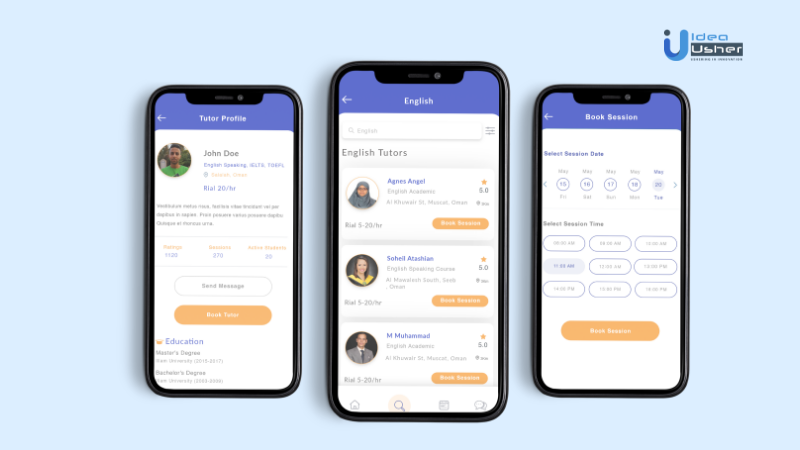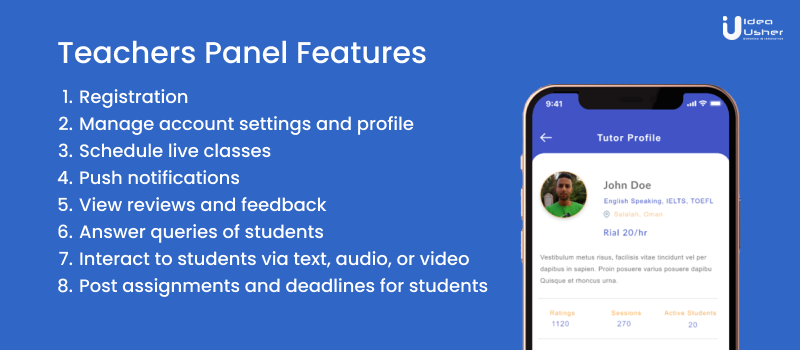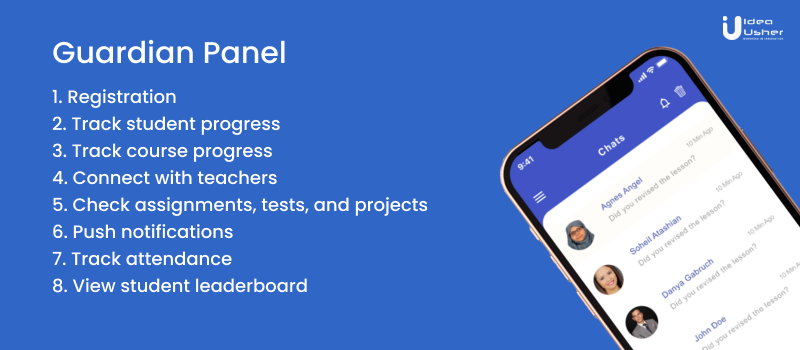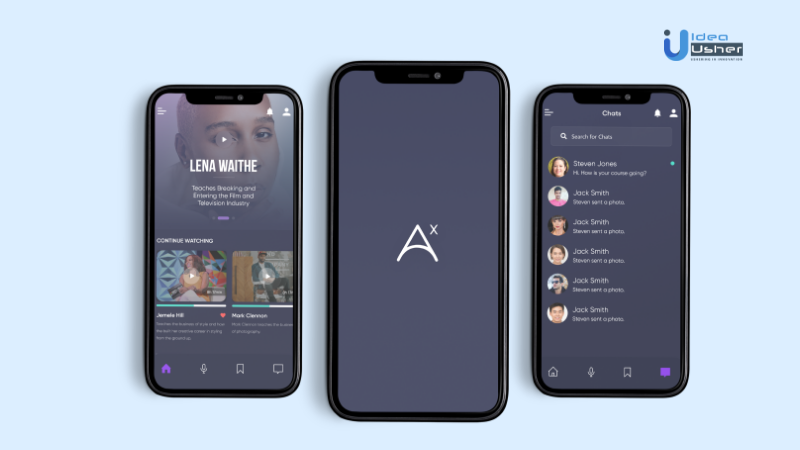In today’s highly competitive world, it is essential to be updated with new skills and the latest technology. Thus, e-learning apps are becoming extremely popular among different age groups. An online learning app can provide anyone access to highly qualified trainers for just a few bucks. e-learning app development incorporates entertainment into learning, which draws learners’ attention.
With an app like AcceleratedX, experts from different industries can share their expertise with millions. The app provides a platform for faster learning and top-notch quality lessons. It proves to be the perfect solution for learning and teaching across the globe.

Developing an online learning app is both a challenge and an opportunity. The challenge lies in the fact that schools are designed to teach learners who are present, in real-time, front of their teachers. With the transition to virtual, schools have to rethink the very design of their classrooms.
The opportunity lies in the fact that virtual learning can reach out to students all over the world. It enables students to:
- learn at their own pace,
- attend school whenever convenient for them, and
- take courses that are not available at their present location.
Why Get On-Board with e-learning App Development?
Here are some of the statistics that show how rapidly developing the sector of online learning is in 2021. If you want to develop an e-learning platform, then this is the right time!
- From 2020 to 2025, the virtual learning market is expected to increase by 200%. (Source: Forbes)
- 42% of US organizations have noticed an increase in their income because of online learning. (Source: The Educators)
- After the pandemic, 90% of the countries adopted the distance learning process. (Source: Research and Markets)
- With a growth of 15%, the corporate online learning market is expected to reach $50 billion by 2026. (Source: Business Wire)
Types of E-learning Platforms With Examples
Distance learning apps can be divided into the following three types based on their purpose and target audience.

1. Personal Learning
The distance learning app is the most convenient type of personal learning. The online courses are already created. So one can start using them almost right away. You can learn at your own pace and at your convenience. It is one of the significant advantages of this learning app category.
Here are some of the prominent examples of educational apps for personal learning.
i. Edmodo
Students can use it to post photos, videos, links to news articles, or questions. You can set up groups for your school or class. Teachers can use it to do the same things as students, They can also assign work and provide feedback. Also, parents can see what’s going on in their children’s classes.
You can also use Edmodo to:
- share documents,
- upload class schedules,
- set upgrade books, and do much more.
ii. Khan Academy
Khan Academy (founded by Salman Khan) is a non-profit organization that has created over 3,400 videos on math, science, history, and more. They also produce language lessons as well as exercises in writing, grammar, and early math. The Khan Academy now has twice as many students who get their material from teachers than from home: teachers assign lessons and give students practice problems. The students practice on the website until they master them enough to do without further help.
iii. Seesaw
Seesaw is a new kind of online learning community. In most online communities, you can post questions and answers, but when you do so, the only feedback you get is from people who have chosen to follow you. In Seesaw, your questions and answers are public. Anyone in the community can comment on them.
2. Corporate Training
Virtual learning apps are widely used in corporate training because they allow companies to train their employees without spending time and money. Check out some of the most popular learning apps used for corporate training.
i. Moodle
Moodle is an open-source, online learning platform used by universities, schools, and businesses worldwide. It helps educators create powerful online courses with course management, discussion forums, quizzes, surveys & grade books.
It is designed to support face-to-face and distance learning courses and is compatible with all modern web browsers and operating systems.
ii. Yammer
Yammer is an employee social network. It is popular in Silicon Valley, where companies like Intel use it. Yammer is like a corporate intranet, except instead of talking to the whole company at once, you speak only to people in your division or department. Your division or department can set up sub-websites private to that division or department; then, employees can talk about their projects without cluttering up the leading company site.
iii. Lynda.com
With over 4500 courses available in total on Lynda.com, learners can build a new career skill set or advance in their current role at work or play at home. Lynda.com improves lives by helping people learn business, software, technology, and creative skills to achieve their personal and professional goals.
3. Educators App
Virtual learning apps are ideal for teachers to teach students virtually. The app is simple to use, and the interface is not complex. The app provides many resources for teachers to share their materials, resources, and lesson plans. Here are some examples.
i. Nearpod
Within the Nearpod app, teachers can access eight different tools they can use to deliver lessons. The presentation of each class is highly customizable and can include text, pictures, and video. Nearpod also provides a full suite of assessment tools that give teachers real-time data about how students are doing in a lesson.
ii. Google Classroom
Google Classroom is an online and mobile application that allows teachers to create classes, share documents, and provide feedback all in one place. It integrates with Google Apps for Education, including Gmail, Drive, Calendar, and Classroom.
iii. Kahoot
Kahoot is a free app for teachers and students. It allows you to create, play and share interactive quizzes on your iPad, Android phone or tablet, and the web. Teachers can use Kahoot to develop interactive lessons and assessments easily. Kahoot also generates detailed reports of student performance which you can export for further analysis.
Features of a the best Online Learning Apps
The possibilities of mobile learning are tremendous. As a result, the mobile distance learning app market is also booming. If you want to design a great application, the first step is not to create the application. The first step is to develop the problem. The second step is to design a solution for that problem. Then you can figure out how to build it.
For a learning app a good problem statement would be something like: How can we teach students so they understand what they are learning and can apply it outside of class? Share on XThe following are some features that you need to know before you get ready to develop such an app.
Student Panel Features
The party that will interact with an e-learning learning app the most are students. You need to ensure that the interface is engaging but not distracting. The staple features to be included in the student panel app are as detailed below.

1. Delivery System
The content delivery system of a virtual learning app is an integral part of the app. Apps have a database that holds all of the information in a structured manner to deliver content. This database is what makes the information in the app available for use. The database can be stored in a device, in a cloud, or both places.
2. Tests, Exercises, and Quizzes
An excellent online learning app should have tests and quizzes. The teachers can check whether the learner has mastered the information. It can also help to motivate the learner to keep learning. A distance education app should give tests after every lesson, no matter how much or little information the teacher covers in that lesson.
3. Personalized Learning
Personalized learning is not about getting people to watch videos or listen to podcasts. The idea is that we can use software to tailor the experience of learning to the way students think and learn.
4. Games
Gamification is the use of game-like techniques to foster engagement in non-game contexts. Gamification can be used in education, where it’s more often called game-based learning. Some elements of gamification include:
- Badges and points: These are visual and textual indicators of progress or activity within an app.
- Reward loops: These actions can be activities such as receiving badges or points or earning virtual currency.
Gamification mechanics often add value to the overall app experience while also increasing engagement by adding an element of fun.
5. Push Notifications
The app employs push notifications to help motivate students and to improve their engagement with the learning process. Push notifications are messages triggered by the app developer and delivered to a user’s device outside the standard app delivery process. The notifications can be sent at any time and should be relevant and personalized.
For example, you can use push notifications to inform students about important events like tests or quizzes and remind them about returning assignments, asking for feedback on a previous lesson, or promoting an online discussion.
6. In-Application Messaging
Teachers can use in-application messaging to send out rewards, reminders, and nudges to learners, encouraging them to continue their studies.
They could send messages to the student’s mobile device(s) while using the mobile app. It allows you to extend their mobile learning experience further and help increase learner retention.
With in-application messaging, students can send a question with one tap. The instructor can then answer it immediately or schedule a time that works for both of them. In either case, the student receives a notification when the instructor has responded to.
7. Payment Channels
If you are building a mobile app for web-based learning, payment channels can help you. You can use them to create a paywall or charge for an in-app purchase. Payment channels also have several other advantages, including security and speed.
8. Social Media
Social media integration is a feature of web-based education apps that are supposed to make learning more interactive. The idea is that the app will connect the learner with other learners using the app and provide a way for them to share thoughts and ideas.
This kind of social interaction helps students feel more engaged and allows them to network with each other.
9. Easy Login
The login page is the first user experience when using your app. The users will be annoyed when it takes too much time to log in or when they need to fill in personal data.
If you want to create an easy login, add a feature to log in with their Google account. It will save your users time and effort and will enable them to use their already filled-in profiles.
10. Offline Learning
Most distance learning apps include some way to download content. One option is the “download” link next to each lesson. Another option is the “download all” button at the top of your course list.
Teachers Panel Features
A web-based learning app for teachers should be easy and efficient to use. The interface, which is what the users interact with, should be simple and elegant. Designers can use different techniques to achieve these goals, such as removing unnecessary features and streamlining the layout of the interface.

1. Registration
To enroll in a course, you will need to register. After entering your data, you will receive a confirmation email.
In the meantime, you have the option to set a password for access to your account. You can access your dashboard at any time by logging in with your username and password.
2. Manage account settings and profile
The app allows users to edit their profile, update their account information (contact number and email id), and change their password.
3. Schedule live classes
This application can be used to schedule and conduct live classes and upload video recordings of the classes. Students benefit from interacting with teachers in real-time through video conferencing or audio calls for live courses. They can also refer back to class recordings for revision purposes at a later date.
4. Push notifications
For a virtual education app for teachers, you could create push notifications. If a learner gets stuck on something, your app could send you a message.
You could also choose to receive push notifications when learners are making rapid progress.
5. View reviews and feedback
As teachers create courses, they can also get feedback on their doing without leaving the app. The teacher can use it to gauge how students are doing and go back and make changes to improve the courses.
6. Answer queries of students
The most important feature of an online teaching app for teachers is the ability to answer students’ doubts. The fact that a course can be accessed from anywhere and at any time is excellent. But if you can’t talk with your teacher, it is useless. That’s why the best online education apps include tools through which teachers can receive and solve the doubts of their students.
7. Interact to students via text, audio, or video
Distance education applications for teachers are built to assist the teacher in carrying out the day-to-day tasks at hand. For example, they allow teachers to create text, audio, or video lessons that they can deliver through a web-based learning platform to students’ mobile devices.
8. Post assignments and deadlines for students
As a teacher, you can set up an assignment and deadline. Furthermore, you can set up a series of works. The students will send their answers directly to you. The students will post replies to each other under your main topic heading.
Guardian or Parent Panel
Guardians are the persons responsible for the wellbeing of their children. The app’s features help the Guardian understand the kid’s behavior and habits and how they work. Parents can monitor their kids’ learning activity using this app. And they can also view the activities done by their kids on their smartphones and tablets.

1. Registration
The app’s registration process is as simple as possible. The guardian fills in a short form to register their child and then selects one or more guardians to notify.
2. Track student progress
Virtual apps for guardians will not only make it easy to keep track of what your kids are doing at school but will also help you understand how they’re doing in real-time. The app will let you know if your child struggles with a particular concept by flagging their progress report with a yellow, orange or red light.
3. Track course progress
Guardians can use these apps to track the child’s course progress. Along with that, they can follow their child’s activity and grade performance.
It allows the guardian to track their ward’s attendance, examination schedule, and grades. It also enables them to review the learning material in videos, PDF files, etc.
4. Connect with teachers
It could enable guardians to connect with teachers, get their questions answered, and participate in the learning process with their children. It would be beneficial because it can increase communication between guardians and teachers, which will lead to a more effective learning environment for students.
5. Check assignments, tests, and projects.
A parent or Guardian can also view a student’s assignments, projects, and tests. It is a big deal for students who might otherwise fail to take their work seriously during the summer months. They will appreciate their parents’ interest.
6. Push notifications
Push notifications are essential for the app to provide guardians with timely alerts about their children’s activities and performance. It also means that they can take action without checking the app obsessively regularly, which will make their lives easier.
7. Track attendance
The guardian can view the attendance details of each student online. Along with the name and photo, guardians can also see the attendance percentage, class, and subject for which the student is present.
8. View student leaderboard
Students are ranked on the leaderboard. The guardian can view the student’s progress and send encouraging messages to their students. The messages can be sent directly from the app without any need for communication with the teacher. It is a simple way for guardians to encourage when it is needed.
Admin Panel
Admin panel is a management panel. It is used by the owners or administrators of any website to manage the site. The admin panel contains all the functionalities of the website. These functionalities can be divided into two sections: one is for managing content, and the other is for managing users and their profiles.

1. Manage students and teachers
A user management section is where you can create and delete accounts and set up user profiles. You can also assign additional permissions to individual users and change their passwords.
2. Manage subscription plan
The app will enable the admin to create a subscription plan and upgrade a user to a new project.
3. Manage student information
The admin panel needs to build databases that store students’ information in an organized way that will be easily searchable and updated by different departments or teachers.
4. Manage community content
A content management section is where you can add and edit existing content and preview how it will look on your app.
Cost of e-learning App Development
If you are making an online app, the best way to start might be to focus on the learner’s perspective. Think about what would be fun for them. Ideally, it will have the same “aha!” feeling of getting something difficult right after struggling over it for a while.
Then think of how the teacher could help the learner get there faster. You can always add more content later.
When it comes to distance learning solutions, the cost of developing an app depends on the factors below.
1. Features and complexity
The first one is the complexity of the course content. If you have a lot of video content, audio content, text content, or interactive exercises, the cost of developing an e-learning learning app will be higher. For example, if you want to add the feature of a chatbot in the app that can engage and solve doubts of students at a primary level, you will need to add in the cost to develop a chatbot.
2. Choice of platforms
The second factor is the platform you are choosing for your solution. If you plan to develop your online education solution on iOS devices, it will cost more than creating it on Android devices.
3. App development team
The number of people involved in creating an app affects its cost. If you need only one developer, you will have to pay them less money than if you need a whole team for this job. And conversely, if your application is very complex, you will need more developers to finish it on time.
If you are creating a full-fledged online learning app, then hiring an experienced developing team such as that housed by Idea Usher is the best way to ensure that all the app features are blended seamlessly.
Other factors such as the target audience can also influence your cost of development. The bigger it is, the more expensive your web-based education app will be.
Last Words
Building an e-learning app involves time, money, and many stakeholders. Many people think designing and building online learning apps is complex. A costly task where there are multiple challenges they don’t know how to tackle.
At Idea Usher, we’ll help you create a virtual learning app with our affordable solutions. We provide virtual management solutions which include web conferencing, online training courses, presentation slides & scripts, classroom simulations, teacher lectures & control systems, etc. All in one answer at a competitive rate!
FAQs
1. How big is the virtual learning market?
The online learning market is rapidly growing and is expected to reach $325 billion by 2025.
2. How many students take online classes?
As per a study of 2017, 19% students took a form of web-based learning. The percentage has increased exponentially since the pandemic.
3. How do I create an online learning app?
First, choose the niche in which you want to create the app. Find a development team to develop the idea and create a demo app.
4. What are examples of e-learning?
Various forms of e-learning are present such as podcasts, MOOCs, video streaming services, forums, etc.




















